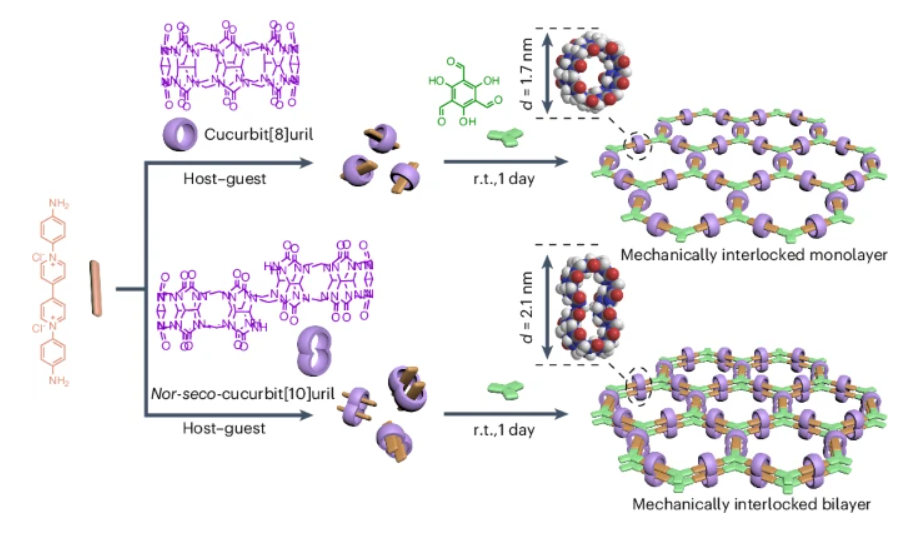Two-dimensional polymers (2DPs), comprising mono- or multilayer covalent polymeric networks with long-range order in two orthogonal directions, are of considerable interest due to their unique physicochemical properties. However, achieving precise thickness control from monolayer to bilayer, crucial for exploring proximity effect-driven phenomena beyond the monolayer limit, remains synthetically challenging. Here we report the on-water surface synthesis of crystalline mechanically interlocked monolayer and bilayer 2DP (MI-M2DP and MI-B2DP) films by embedding macrocyclic molecules with one and two cavities into 2DP backbones. The incorporation of bulky macrocyclic molecules introduces periodic mechanical bonds that precisely control interlayer interlocking, enabling selective monolayer or bilayer 2DP formation. Both MI-M2DP and MI-B2DP exhibit homogeneous, large-area films with ordered hexagonal pores and high modulus. MI-B2DP demonstrates an exceptionally high effective Young’s modulus of 151 ± 16 GPa (indentation method), surpassing MI-M2DP (90 ± 14 GPa), van der Waals-stacked MI-M2DPs (46 ± 11 GPa) and other reported multilayer 2DPs (<50 GPa). Modelling confirms that the mechanical interlocking minimizes interlayer sliding and reinforces the structure.

Two-dimensional polymers (2DPs), comprising mono- or multilayer covalent polymeric networks with long-range order in two orthogonal directions, are of considerable interest due to their unique physicochemical properties. However, achieving precise thickness control from monolayer to bilayer, crucial for exploring proximity effect-driven phenomena beyond the monolayer limit, remains synthetically challenging. Here we report the on-water surface synthesis of crystalline mechanically interlocked monolayer and bilayer 2DP (MI-M2DP and MI-B2DP) films by embedding macrocyclic molecules with one and two cavities into 2DP backbones. The incorporation of bulky macrocyclic molecules introduces periodic mechanical bonds that precisely control interlayer interlocking, enabling selective monolayer or bilayer 2DP formation. Both MI-M2DP and MI-B2DP exhibit homogeneous, large-area films with ordered hexagonal pores and high modulus. MI-B2DP demonstrates an exceptionally high effective Young’s modulus of 151 ± 16 GPa (indentation method), surpassing MI-M2DP (90 ± 14 GPa), van der Waals-stacked MI-M2DPs (46 ± 11 GPa) and other reported multilayer 2DPs (<50 GPa). Modelling confirms that the mechanical interlocking minimizes interlayer sliding and reinforces the structure.
